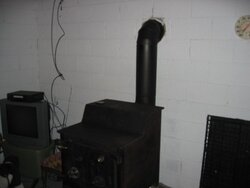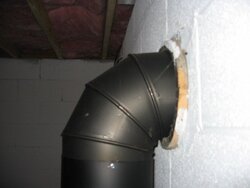We just purchased a home last year with a cinder block wall/concrete floor unfinished basement. It also came with an old Fisher woodstove in the basement that I plan to replace with a smaller more efficient stove at some point. Last winter I learned that it is pointless to try and heat the basement with the stove since the block walls are not insulated.
We are about to start a basement finishing project down there where I will insulate the walls with rigid foam and install drywall on the foam using furring strips.
What do I need to do in the area where the stove pipe enters the chimney through a thimble in the existing block wall. As shown in the photos, I know I will need to move the stove further into the room (away from the new wall). What type of insulation can I install in the vicinity of the stove pipe? Any advice or website links would be greatly appreciated.
We are about to start a basement finishing project down there where I will insulate the walls with rigid foam and install drywall on the foam using furring strips.
What do I need to do in the area where the stove pipe enters the chimney through a thimble in the existing block wall. As shown in the photos, I know I will need to move the stove further into the room (away from the new wall). What type of insulation can I install in the vicinity of the stove pipe? Any advice or website links would be greatly appreciated.



